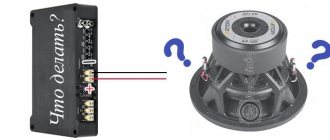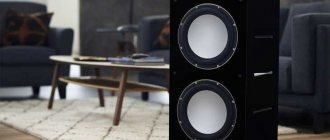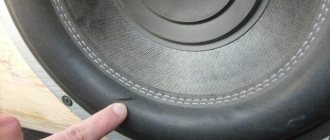Car acoustics have long become an integral part of modern vehicles. Depending on the purpose of installing the sound system, speakers are selected that suit the car owner in terms of sound quality. If the driver listens to the radio during a trip, a low-frequency speaker https://audiotop.ru/ratings/luchshie-midbasy will do. For frequent listening to music at low volumes, standard midbass units with a standard bass level are often used. If the built-in devices do not satisfy the motorist's requirements, they will have to be replaced with mid-frequency speakers.
What is midbass?
A mid-bass speaker is an acoustic technique that gets its name from the frequency range it reproduces. The average frequency is 60-500 Hz. This is shallow, but quite noticeable bass when listening to music. Because of this feature of sound reproduction, low-frequency speakers are installed in the rear. Such speakers become an integral part of speaker systems without a subwoofer. Without midbass with high-quality tuning, you should not expect good sounding acoustics.
Agree, it is difficult to imagine an orchestra without cellos, bassoons and horns. Similar sounds and frequencies are reproduced by midbass. Without it, car speakers play music with sound gaps. The melodies will not be perceived as deep, warm, natural and rich enough.
The midbass setting brings with it the masculinity (and not the squeakiness) of male voices, percussive sounds, the color of the blows with a characteristic heaviness, and the density of the bass guitar.
Midbass selection criteria
Main selection criteria:
- Diffuser diameter. The larger the diffuser, the lower frequencies the speakers reproduce.
- Diffuser material. For production they use paper, polypropylene, carbon fiber. The more rigid the material, the less distortion.
Good midbass speakers have a sensitivity of at least 90 dB, a flat frequency response up to 2000-3000 Hz and a first-order crossover.
An important factor in the choice is the power of the device, as well as the fact whether it is planned to use an amplifier or the connection will be made directly to the radio.
Technical characteristics of midbass speakers
The most popular among music lovers are speakers with a diameter of 16 or 20 centimeters. To evaluate the technical parameters and design features of the midbass, consider the characteristics based on 16-centimeter speakers:
- resonant frequency within 40-80 Hz;
- frequency range from 60 Hz to 5 kHz;
- power within 20-100 W;
- sensitivity up to 92 decibels;
- quality factor Qts, 0.3-1.2.
The design is represented by a single-wave rubber suspension - a subwoofer-type lip. Midbass units are rarely sold separately. Often this is part of a built-in, standard car audio system, installed on the doors.
Difference from bass
Woofers and subwoofers operate in the low frequency range, which is why they are similar. The difference between midbass speakers and bass speakers is that the subwoofer covers the lowest bass of 10-80 Hz (and “heavy” subs reach 50 or even 45 Hz), and midbass operates with frequencies from 80 Hz and above. There are other distinctive features.
- Installation. It is better to place mid-bass speakers on the front doors. The sub is fixed in the back: on the acoustic shelf;
- in a closed box (not the best choice);
- phase inverter (ZA with an acoustic tunnel that reduces resonance);
- rear shelf;
- acoustic shelf.
- When the subwoofer plays, the whole car vibrates. Rock music becomes especially rich and deep precisely because of the subwoofer.
To experience not just loud, but dense music, when each instrument sounds clear, you need to display all sound frequencies.
What are midrange speakers
Inexperienced motorists often confuse midbass with midrange speakers. The first ones are cheaper. Therefore, car owners, saving money, replace midrange speakers with midbass speakers. You need to understand that such acoustic elements are not interchangeable when it comes to high-quality sound.
Mid-range speakers are distinguished by increased power and sensitivity, increased volume, and expanded frequency range. If the indicator exceeds 200 Hz, such acoustics sound brightly, without extraneous noise. In this case, the soft bass and punch inherent in midbass will be absent.
Technical characteristics and features of midrange speakers
To evaluate the advantages and identify the disadvantages of mid-frequency speakers, let's consider these acoustic devices for cars using the example of modifications with a diameter of 16 centimeters. Midrange speakers have the following operational parameters:
- resonant frequency varying between 60-120 Hz;
- frequency range ranging from 70 Hz to 13 kHz;
- power indicators within 60-200 W;
- sensitivity up to 91 dB;
- quality factor Qts is no more than 0.7.
Such acoustic systems are represented by designs with a multi-wave fabric suspension, which is radically different from the structure of a subwoofer. These can be either structural elements of an acoustic system or independent powerful devices.
Cost of midbass speakers
The price for a pair of high-end midbass woofers is about $300. You can find cheaper products, in particular, for a pair of woofers (also called modbass) you can pay 50-80 dollars. How to decide which option is the best available? Is it possible to navigate by price? First of all, don't forget what size you need - 16 cm, 20 cm, 13 cm or 10 cm.
As practice shows, the best midbass is not always the most expensive. The most popular are 16 cm, 20 cm. Car audio stores offer a large number of options in different price categories. It turns out that the Ural midbass is capable of competing with many competitive models. Each of the proposed models has its own characteristics. First of all, it is taken into account what type of speaker - two- or three-way.
Midbass speaker
An important element is the diffuser and its type – low and mid-frequency. Depending on the material used for manufacturing, it has different damping properties.
Sound characteristics include:
- sensitivity;
- dynamic characteristics;
- sound detail;
- structured bass.
An important point when purchasing is also considered a compact design, suitable for installation in the interior of a modern car, suitable dimensions for 16 cm, 20 cm outlet diameter. Based on the listed properties, you can choose a model that is suitable for yourself, corresponding to a certain purchase budget. Which one should I take from the available ones?
Midbass acoustics
So what to choose
Comparing midrange speakers with midbass speakers, we can conclude that the former are much more powerful and louder. The latter are more sensitive and kind. Although this statement cannot be said to be categorical, since the range of car acoustics is constantly expanding. Now you can find universal systems for car audio, which are something statistically average between midbass and midrange.
The car audio system is a kind of orchestra, where each element is assigned a specific role. Component acoustics in a car are often represented by systems that have mid-range speakers, tweeters, a subwoofer and midbass. The components of the chain work together to guarantee pleasant and high-quality sound. The absence of at least one component immediately disrupts balance and harmony. Therefore, it is impossible to replace the midrange with bass speakers, and vice versa.
Source
How to properly install car audio
The best option for installing a speaker system in a car is considered to be the following: coaxial speakers are installed at the back, in the rear, and component speakers (tweeter and midbass) are installed at the front. Thus, it will be possible to provide full-fledged, real sound, which many car owners who have improperly organized car audio are waiting in vain.
Coaxial acoustics are always a cheaper option, considered by experts as a model for the undemanding car owner who only needs some sound. For example, the speakers play well, the sound is loud, nothing wheezes or growls. In this case, a little money will be enough to choose the best model among coaxials.
Bass acoustics
On the contrary, if a car owner is looking for something more serious, and is not limited to just the desire to get mediocre sound, he should pay attention to component acoustics. This one costs about 30 thousand rubles today. Of course, the KMP acoustics also include high-quality midbass.
For a music lover, good acoustics are akin to a car engine. Most modern cars do not have a good, real sound system installed. The only exceptions may be the top versions of cars. As a result, there is a desire to acquire new speakers, replace the head unit, install a powerful subwoofer, etc.
Installation of acoustics
This is perhaps the most important, complex and time-consuming stage of building an audio system.
First you need to learn another axiom:
90% of the sound of an acoustic system depends on the correct selection of its installation and configuration, and only 10% depends on the speaker design itself.
Another myth - a misconception among beginners:
My speakers are cheap speakers and there is no point in me bothering with a proper installation.
When installing acoustics, you need to pay the closest attention and approach the process as carefully, thoughtfully and meticulously as possible, regardless of the price of your equipment. Otherwise, regardless of your maneuvers, inevitably, you will simply receive different versions of the disgusting sound. When installing sound, there are aesthetic aspects that depend entirely on your desire to bother with the installation, and technical aspects that need to be taken care of in any case.
Tweeters
The high frequency range is very easily damped by obstacles and reflected from them. You can conduct a simple experiment by covering the tweeters with your hand or some hard, flat surface. Therefore, the HF must be placed closer to the level of the head in front of the listener so that there are no obstacles between the ears and the HF. It’s also not a good idea to lift the tweeters up to the ceiling. This will simply break up the sound.
This is precisely why coaxial speakers installed in the legs will never sing normally, even if their owners tear their vests, proving that the sound is excellent, that everything suits them and that they don’t go to competitions.
The corners of the door mirrors or the side pillars of the windshield are excellent places to install tweeters. Everything is simple here.
Much more questions arise about the orientation of the HF in the cabin. Where should the HF be directed correctly? There is no clear answer to this question.
Someone is pointing both high frequencies at the driver.
Someone is pointing the HF at the opposite listener. (yours for the passenger, passenger’s for you)
Someone is directing the HF to the center of the cabin between the front seats.
Someone sets the HF to reflect from glass.
All these options have a right to life, but which one will sing best in your car, with your high frequencies and for your ears is best determined experimentally.
Take double-sided tape and rehang the HF in different ways every two days. This is a great way to evaluate each method and choose yours. The only thing I can recommend is to ride with each option for a day or two. Sometimes the initial wiretapping creates a misconception.
Another important point to pay attention to:
The stiffer and more durable your tweeters are mounted, the better they will sing.
Accordingly, you should not leave the option you like on the tape. Install the tweeters on their standard mounts, following the rule stated above.
Middles
In a three-way system, it is also best to install the center closer to the listener’s head, on the panel or in the corners of the mirrors. The direction, as in the case of HF, is best determined experimentally.
Separately, you need to pay attention that diffuser centers, like any other speakers, require their own specific volume for proper operation, for which they will work. Recommendations for volume sizes can be easily found in the instructions and on the Internet. But here again there is room for experimentation. I recommend playing with different volumes and listening to the middle parts in them. Volume can significantly affect the sound of the midrange, both for the better and for the worse. And of course, no one bothers you to play with the filler in this volume. It will also have a noticeable effect on the sound.
Well, in this case, of course, the rigidity of the installation and the tightness of the speaker fit into the volume are very important. It is very important that the sound of the rear part of the center does not escape through the slots of the seat and does not extinguish the sound of the front part of the diffuser in antiphase. This phenomenon is called speaker shorting. The phenomenon is not fatal, but can significantly spoil the sound.
Midbass
The vast majority of midbass speakers of component and coaxial acoustics require free-air design.
The diffuser hangers of free air speakers are designed to hold the diffuser even at maximum power without outside help. Such speakers need a volume in which the air will not have a noticeable effect on the operation of the speaker. That is, ordinary midbass will feel great when installed in the door.
They don’t need any box and are even contraindicated. A free air speaker placed in a small volume will lose bass depth and begin to hum unpleasantly with music.
However, simply screwing the speaker to the hardware is certainly not enough for the midbass speaker to work properly. It is extremely important to Mead that his front part of the diffuser is as isolated as possible from the rear part. It is very important to eliminate all holes in the door near the speaker installation location.
In addition, the midbass already has sufficient travel and energy when the diffuser is displaced, which means that when installing you need to be guided by the following rules.
Midbass in the door should be installed:
- as hard as possible;
- as deaf as possible;
- as tightly as possible.
This means that vibration insulation of doors is simply necessary, and there is clearly no point in being modest with noise.
But at the same time, it is worth paying attention to the ease of repairing the door to the Shumka ambassador, and also make sure that the ventilation holes in the door remain open. They won't affect the sound, but they might cause rust. Very often, to give additional rigidity to the seat, plywood spacer rings are used, which are securely attached to the metal of the door, and the speaker is already attached to them.
A midbass mounted on a plastic door trim will NEVER work properly.
In addition, spacer rings can be used to optimally tighten the midbass in a two-way system. This will help avoid dips in the midrange. When installing the rings, it is important to pay attention to their tightness so that the sound passes through them into the volume of the door, and does not go under the casing.
If the door trims are equipped with podiums for mid-bass speakers, then it is best to adjust the spacer rings in such a way that the speakers in these podiums, through the trims, are attached rigidly and hermetically to the rings.
It remains to be mentioned that when connecting the terminals to the door speakers, you need to lubricate the connected terminals with lithol or cyatim. Moisture and condensation often collect in doors. The car speakers themselves are protected from such phenomena, but the terminals are very susceptible to oxidation. The lubricant will repel moisture and save you from the problems of rotting contacts.
Rear acoustics
Coaxial rear speakers are also acoustics for free air design. Therefore, for its normal operation, the entire volume of the trunk is required. Well, in the same way, here you need to be guided by the same three rules and make the shelf for acoustics as rigid, deaf and airtight as possible.
In a standard cardboard shelf, in a shelf made of thin plywood and in a shelf with holes in the trunk, the acoustics will NEVER work properly!
The shelf will have to be made of thick plywood, made airtight and attached not to the standard plastic ears, but to metal as rigidly as possible.
Regarding the rear, it is also worth mentioning a very common mistake of many beginners:
It makes no sense to install rear and sub at the same time!
What's the point of putting a subwoofer in the trunk and then covering it with a shelf of pancakes? Firstly, you will strangle the sub, secondly, it will thresh the pancakes, interfering with them and exceeding their speed, and thirdly, in the cabin you will hear not the sub itself, but the muttering of the pancakes from it at the frequency of their own resonance.
In general, you need to think about why they put a rear at all and whether you need it in your case
You shouldn’t put the rear just because everyone you know does it and because there are regular places for the rear.
The rear is installed either in professional 5.1 multimedia systems for watching DVD video, or if you are planning an initial system of the category “just for something to drone”, in which the front is very weak, and it needs to be at least somehow supported in the midbass area.
Don’t listen to stories from rear owners who say that with the rear the sound is richer, bassier and more voluminous. This just means that the person’s front is poorly established, and he does not cope with his functions normally.
In a competent two-channel stereo system, the rear is basically not needed!
And here, at the same time, we need to dispel the myth that beginners simply adore. We are talking about standard audio systems in cars.
The main argument of these people:
“I have a staff and it has a rear! The staff was made by engineers, and they knew what they were doing"
Personally, I don’t understand where people get the idea that professional sound technicians worked on the standard system of their car, and the company’s goal was to make a car with impeccable sound?
Of course this is not true. When developing a standard car audio system, designers are primarily guided by considerations of efficiency, harmony of the interior and interior design of the car as a whole. And this approach is completely justified. Why, say, should a buyer of a budget car overpay hundreds of thousands of rubles for a professional system that he may not need at all.
A similar myth is spread by newbies - owners of cars equipped with “branded” audio systems with a bunch of speakers. The myth is essentially the same, with the only difference being that it’s a stock unit and this is a BRANDED audio system.
They are partly right and of course there is a difference. Branded systems play very, very well. They are quite capable of satisfying the sound needs of most non-fussy drivers. However, the cost of overpaying for such a system is simply monstrous. Such systems usually play for much less than they cost, and the equipment itself often has nothing in common with a high-profile company other than nameplates on the grilles.
Such systems are designed not so much to provide high-quality sound, but to add prestige to the car itself and its owner.
I repeat, they play very well, but you shouldn’t idolize them.
With your own hands, you can assemble a much better system yourself and it will cost much less. Another thing is that the owner of a top-end car will never do this))
In general, it is worth deciding on the rear before it is purchased and installed, and not after!
Regarding the installation of any acoustics, it remains to clarify a couple more rules:
The acoustics are installed on the most level seat possible! Any crookedness or unevenness when tightening can kill the speaker. If your podium is crooked, don't pull the speaker as hard as you can. You are simply deforming the basket.
When installing speakers, pull the screws or bolts diagonally, but do not immediately tighten them tightly. Press diagonally against all the mounting holes provided in the speaker, and only then tighten the fasteners completely.
I strongly recommend that you drill holes for the screws in advance so that when installing the speaker, the screws go tightly but firmly. Very often, when beginners begin to force the screws, the screwdriver slips and breaks through the speaker. This point needs to be given close attention. Hold the screwdriver with your finger and never rush. This will protect the iron from destruction and you from additional expenses.
Passive crossovers
Crossovers must be installed as close to the acoustics as possible!
It is very important!
Long wires from crossovers to speakers can significantly affect the tuning of the crossovers.
Well, it is highly advisable to install them not inside the door, but under the trim or in the kick panels of the cabin. Crossovers extremely do not like temperature changes and moisture.
We sorted out the technical aspects of installing the acoustics. Now we can talk a little about aesthetics.
A lot of questions arise about how to beautifully design podiums for frontal speakers, and at this stage many are afraid of experiments, believing in absentia that they will not be able to beautifully decorate the speakers in a car on their own. For this, of course, you can turn to professionals in the installation studio. Or you can try your hand and make podiums in a way that does not require special skills and professionalism. All you need is patience and a little free time.
Let's talk about the nuances of working with glass mat and resins.
The first and probably the most important advice in this matter: Take your time! This is not a quick task and is very painstaking. If you don’t want to waste a few evenings on a boring, monotonous activity, then it’s better not to start at all. If you rush, you risk getting a terrible craft instead of aesthetic podiums.
To make podiums for the first time, it is best to use stocking technology, glass mat and epoxy resin.
For the first time it is better to use epoxy rather than polyester. Polyester dries very quickly. This is its main advantage. The downside is the strong, pungent, unpleasant smell. Epoxy will allow you to quickly correct any mistakes or mistakes during the long-term hardening process. And the absence of smell will allow you to make podiums right at home, or on the balcony, devoting 30-40 minutes a day to the process, say, after work.
I’ll show you how to work with these materials using the example of those podiums that I first made for high frequencies and mids. This example is noteworthy in that I cannot boast of the straightness of my hands in such types of work, which means that literally anyone can achieve such podiums.
So, let's go.
Using wood bits, we cut out 2 rings from 10-piece plywood and file them so that the speaker fits tightly into the ring.
At the hardware store, we buy 10 pieces of self-tapping screws of various lengths and 60 nuts for 8. Using them, we set the rings in the desired position and at the desired angle. I used this method because the rings are very thin, less than a centimeter.
We set the rings at different angles and listen to the optimal direction of the speakers.
For tweeters, we file down the plastic linings of the stands and instantly glue in the crystal of the HF clip at different angles, determining the optimal direction until we finally decide.
In the corners of the mirrors we drill 2 holes inside the future podium and in the iron of the door for fastening the center podiums with two screws to help with the standard clips.
The biggest nuance of the podiums was that the elastic band of the door opening overlaps the corner of the decor by about one and a half centimeters when closing. This means that the podium of the middles should not start from the edge of the corner, but with an indentation of a centimeter. We mark with a marker the strip from which the podium will begin.
Before starting the main work, using coarse sandpaper, we roughen the contact surfaces of the stockings so that the resin there will better adhere to the plastic.
We select stockings or stretch material to make the shape of the podium, try on how it will look, and make sure that the stocking stretches enough to provide the desired shape of the podium without wrinkles. On the back side of the podiums we collect the excess stocking with clothespins and tape.
In the place where there should be an indentation of the podium under the elastic band, I pressed it directly through the stocking and smeared the entire strip with the crystal. Gradually pressing each section, I ensured that the stocking was securely glued to the entire surface of the indentation.
I also applied superglue to the place where the stocking was pulled along the ring of the podium. Just in case, so that later after cutting the hole there will be no problems.
When the glue set and dried, I mixed a little epoxy and coated the future podiums with a thin layer.
After 6 hours, when the epoxy began to set, I applied two more layers to the stockings and left them to dry for a day.
After the resin has dried, cut holes inside the rings. By this time the stockings had become hard, but not stone-like. In general, nothing more is needed. Through the holes in the rings, I laid a small layer of glass mat fibers from the inside along all the walls and impregnated them with epoxy.
When the glass mat is impregnated, it becomes pliable and is quite easy to lay on the walls. Make sure that the epoxy flows into every corner of the podium from the inside. If this is not done, then shells and soft areas of the podium will remain, which will collapse under light pressure. At the same time, you should not stuff the glass mat too tightly, so as not to deform the shape of the stocking. Under its tension, the stocking, as a rule, gives an aesthetically optimal shape. You shouldn't spoil it. It is also advisable to apply several layers of epoxy to the base of the podium inside.
This will give additional rigidity to the entire structure.
After the first layer has dried, you can lay another one in a similar way. Only this time you can still apply a thin layer of epoxy once and on top of the podium.
If you need to give some shape to the outside, then lay the required amount of glass mat or fiberglass on top in the right places and impregnate it with resin. Separately, you need to take into account: when sanding glass mat, your hands itch terribly. Like after glass wool. It is better to protect them with gloves. And when laying layers inside, make sure that there is enough space left in the podium for the speaker. It is quite difficult to sand out the inside.
When the second layer dried, the result was unattractive, at first glance, blanks that can already be put in order. We cut off the remains of the stockings, remove drops of resin and drips inside the high-frequency podiums with a file, bringing the back side of the base to its original state.
Now we stock up on various waterproof sandpapers and begin to sand the podium from drops and unevenness. This is the longest process. The sandpaper must be soaked in water periodically. It sands better this way, and the sandpaper doesn’t get clogged, and we don’t breathe resin dust, which obviously doesn’t improve our health.
In the process, all the shells and jambs formed during the formation of the base of the podium will be opened.
At this stage of sanding, you need to give the podium the required shape, remove all excess drops and drips, identify and mark all dents, cavities and places on the podium that need to be given additional shape.
Now we fill the sink with any fiberglass putty or putty on plastic in excess and add larger layers where an additional form is needed. The convenience of working with putties is that they set very quickly. Literally 5-7 minutes after applying the putty, you can slowly sand it off.
You can repeat this process until you either get bored or remove all the jambs from the podium.
As you can see, during sanding the podium becomes spotty and this makes it difficult to see small irregularities. A thin developing layer of primer on plastic will help to cope with this:
When the primer dries, any remaining unevenness will become visible. We mark the unevenness, remove the layer of soil, degrease these places and work again with putty and sandpaper. Then we prime these places again and look at the result until we are completely satisfied with the result. For the middle ones that I installed, it is recommended to dampen the podium from the inside with soft material.
Moreover, my podiums turned out to be a little less than optimal in volume. I dampened the inner surface of the podium with a pattern from a terry towel. The dragon planted the material on glue.
Now we prime all the podiums completely and at the finish, to give a texture similar to the texture of plastic, apply a thin layer of anti-gravel paint.
By adjusting the distance from the nozzle to the surface, you can achieve different paint textures. I recommend practicing on any piece of cardboard or plywood before applying the anti-gravel coating.
If you apply anti-gravel in the cold, I advise you to keep the can in a warm place so that it warms up. Otherwise, the can will spit and spoil the texture in every possible way.
As a result, we get quite aesthetic, and most importantly, quite reliable and durable podiums.
I repeat, I highly recommend not to be afraid, but to try this method. There is nothing complicated here at all, and the process strongly welcomes a creative approach. The option described above is not strict instructions at all, but simply an example of the technology. What to attach, how to display and what to sand with are questions of your ingenuity and only your ingenuity.
The front was installed, and our work came close to the biggest topic of acoustics.
Form factors
One of the determining parameters is the size or form factor. On sale you can find midrange speakers designed for 10 cm, 13 cm, 16 cm and 20 cm. The most powerful of these will be the 20 cm midbass. However, this parameter also depends on a number of characteristics, namely on the manufacturer and its achievements in the field of acoustics.
The size is generally determined not by the desire to choose one speaker or another, but by the installation location. This statement is obvious, and sometimes you can come across similar questions: “Is it possible to install a smaller size, but with improved characteristics?” This can probably be done in a way that violates aesthetics, but there is no need to complicate the process.
Component acoustics 16 cm
To select suitable speakers, check your installation locations and, accordingly, the diameters of the midbass you need. Usually there are standard speakers that can be changed if necessary. Moreover, the type and nature of the installed system largely depends on the vehicle itself. The Volkswagen crossover will have more advanced acoustics than the VAZ. At the same time, do not underestimate the same Ural, which is installed in the door, in front and behind the cabin.
Kicx PRO 6020
What is Mid in car audio?
A midbass is a speaker that reproduces the mid-bass range of 80-400 Hz. If we are talking about rear acoustics, then midbass, within the frequency band of 80 Hz. ... up to 200 Hz, she doesn’t need it, which means “ordinary” 13cm is really enough.
Interesting materials:
What is the registration number in the Pension Fund of an individual? What is sleep regression? What is rating in media planning? What is a Reviewer? What is a recession in medicine? What is jealous? What is jealousy in a relationship? What is jealousy? What is a reserve fund? What is a stiff neck?
Main characteristics of midbass sound
To choose a truly high-quality and suitable speaker, you should focus on the main indicators that you will need to focus on. Any professional who understands car audio will highlight the following sound characteristics:
- sensitivity;
- sound detail;
- dynamic indicators;
- structured bass.
Only if there is a combination of all these points in one speaker model can we talk about their quality. In this regard, we can highlight the products of the Alphard company, which are widely represented on the website spartamarket.ru. Alphard midbass is used to equip cars even by very sophisticated music lovers. In addition, the factor of compact design is also very important, since all modern cars, as a rule, have space for installing speakers with a diameter of 16-20 cm.











